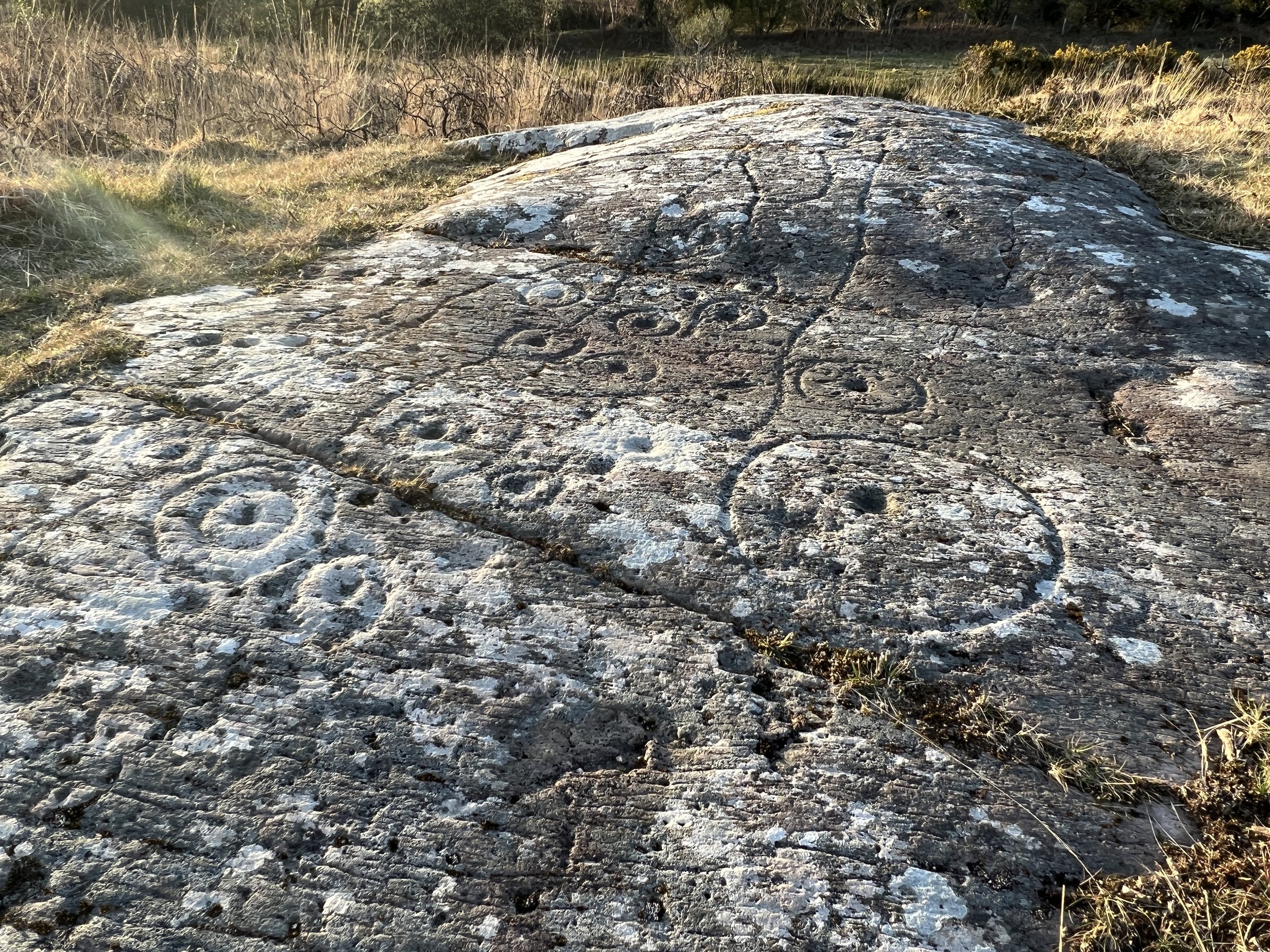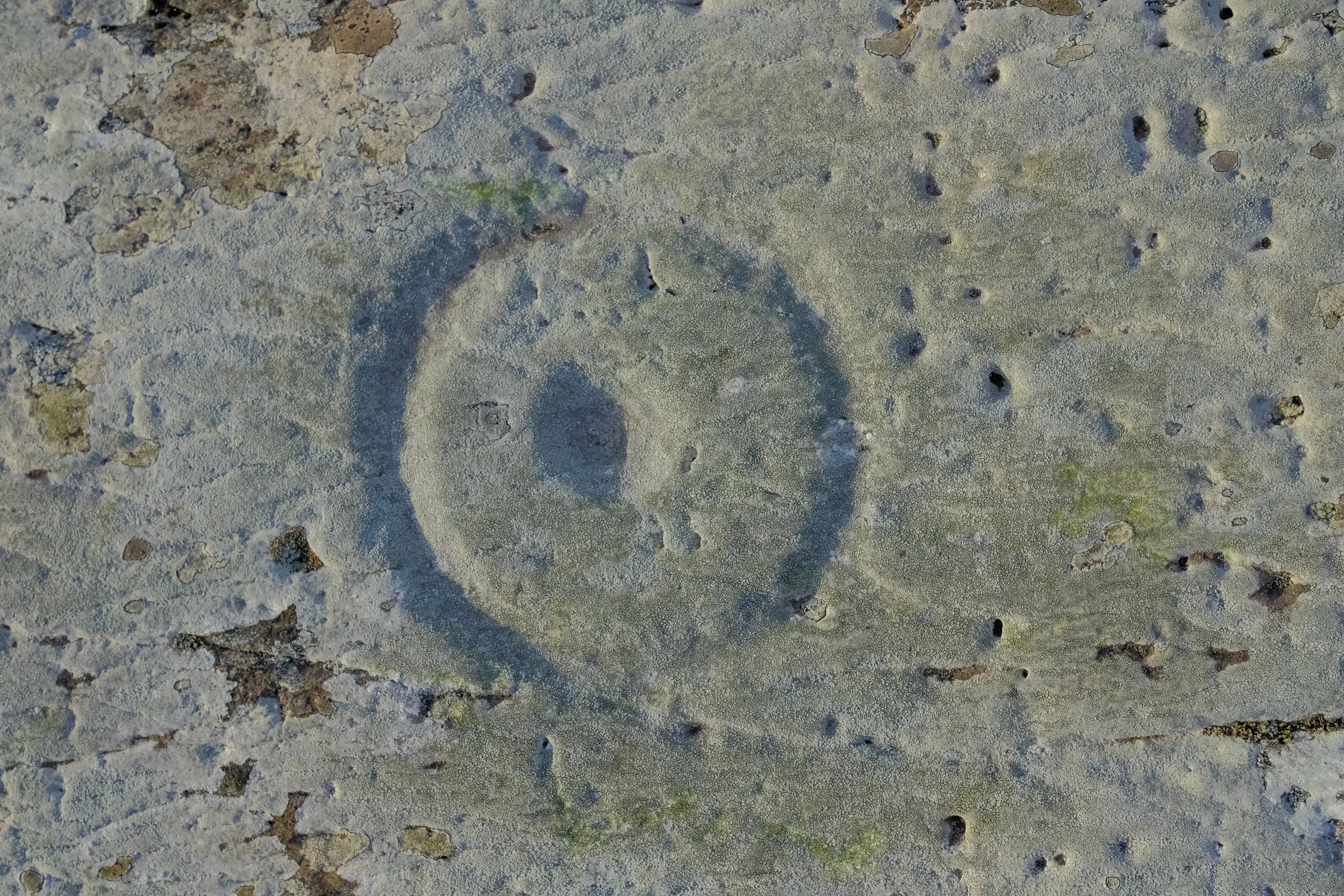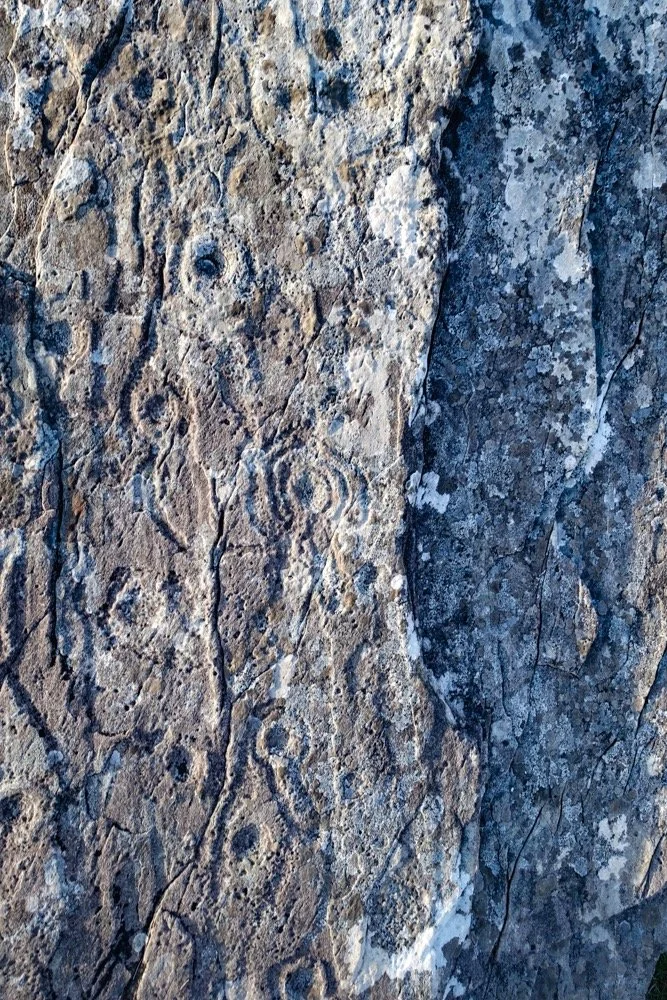Rock Art
The greatest of Iveragh’s many cultural treasures is rock art. Certain parts of the peninsula appear to be festooned with it! You can walk into boulder-strewn pasture and here and there on the rocks are enigmatic carvings of hollows enclosed by rings. Quietly and unobtrusively inscribed on the rock surface, they are easily overlooked until they are suddenly dramatically highlighted by the oblique rays of the rising or setting sun.
What does rock art look like?
Rock art is a generic term that refers to carvings and paintings on rock. In Ireland, we have a particular genre of megalithic-era open-air rock art called cup-and-ring art after its quintessential motif. This ‘cup’ is a round hollow that is often enclosed by one or more rings. Grooves also feature, generally either running from a cup-and-ring mark or meandering across the rock surface. Cup-and-ring rock art, notwithstanding its limited repertoire of motifs, is infinite in its variety. The size, shape, scale and depth of the carvings and the way the motifs are arranged on the surface make every rock art panel unique. The rocks selected for carving can be boulders or stretches of natural rock outcrop. In rock art parlance, any stone with rock art is called a ‘panel’. Some panels are cupmarked only. Others are elaborate, and as they are consistently located in landscapes with sweeping views.
Where is it found?
Iveragh is the rock art capital of Ireland! About one third of the whole of the island’s rock art panels are found on this single peninsula. The known number of panels Island-wide has nearly doubled since 2014, with the number of panels on record currently standing at about 1000. The greatest concentration of rock art panels in Ireland is on the Iveragh peninsula, the figure of 300 panels set to increase as more panels continue to be identified.
Nationwide rock art is rare, with the occasional cluster in counties Donegal, Monaghan, Wicklow and Cork. Cup-and-ring rock art which is similar to ours is also found in Wales, Scotland and England, parts of Spain and Portugal and even further afield. It is often referred to as Atlantic rock art due to the proximity of many of these regions to the Atlantic ocean.
The landscape setting of rock art
Whereas passage tomb art (also known as megalithic art) is found on large ancient stone structures known as megaliths (from the Greek ‘mega’ meaning large and ‘lith’ meaning stone), rock art on natural rock surfaces in open-air pasture is a barely noticeable intervention in the landscape. Research suggests that various considerations were taken into account when selecting which rocks to carve - these include the proximity of rocks to routeways, their views to water and alignments with natural and astronomical phenomena. As much of the Iveragh peninsula has never been developed and is unspoiled, our rock art is exceptional for remaining in exactly the same positions as when they were carved all those thousands of years ago, in landscapes which retain much of their Neolithic aura.
How old are they?
These carvings are very old indeed! Rock art is difficult to date as the carvings themselves cannot be radiocarbon dated. However, current research and results from excavations suggest that rock art was made towards the end of our Stone Age, about four and half thousand years ago. This last, or most ‘recent’, phase of the Stone Age is called the Neolithic and began some 6000 years ago when eagles, wolves and bears were commonplace in Ireland. The Neolithic lasted for about 1600 years (4000-2400 BC). During this time, with the advent of agriculture, the nomadic hunter/gatherer lifestyle which had previously prevailed was replaced by a more settled way of life. It was also the time during which passage tombs such as those at Newgrange, Knowth and Dowth in Co. Meath were built.
Rock art and passage tomb art
Although the exact nature of the relationship of rock art to passage tomb art is not yet understood, they share many similarities. The ‘art’ of the two genres is created on stone and made largely by hitting the rock surface with a harder stone to create hollows or rows of small indentations (called pickmarks or peckmarks) which can form grooves. We have no painted rock art (that we know of) and few motifs in either genre are made by incising the rock i.e. by drawing a sharp point across its surface. Both passage tomb art and rock art have a limited repertoire of motifs which are geometric. A small number of motifs are common to both genres e.g. the cupmark, the cup-and-ring and the rosette. Neither form of carving is figurative i.e. people and animals do not appear to be represented. Elsewhere in the world, both people and animals, especially deer, are frequently depicted in rock art.
Another important characteristic which is shared between rock art and passage tomb art is their occasional occurrence in proximity to one another in the same landscape. This can be seen at Loughcrew in Co. Meath and, in Wales, on the Isle of Anglesey.
Rock art on megaliths
A small proportion (c. 5%) of the 1,000 or so rock art panels in Ireland is found in association with megalithic-era monuments. It is rarely clear when exactly the rock art component of the monument was made – before, during or after the erection of the megalith? Some of these megaliths, such as portal tombs, date to the Neolithic. Frequently referred to as dolmens, portal tombs in Ireland are occasionally inscribed with rock art while cupmarks can be found on similar structures in Wales on the Llŷn Peninsula. Rock art can be incorporated into Bronze Age monuments such as wedge tombs, stone circles, stone rows, standing stones and cist burials.
Why is megalithic-era open-air rock art important?
Rock art is a direct and tangible connection to our Neolithic and Bronze Age ancestors. When we visit rock art panels, we stand exactly where the people who made the rock art once stood and look at the same landscape they did from the exact same position. The carvings are durable and were obviously deemed worthy of the effort and time it took to make them. Many of its qualities, such as its beauty and mystery and the fact that it must have been of profound importance to those who made it, can be appreciated by us in the present without our necessarily understanding its meaning and purpose.
Thoughts on the meaning of rock art
Theories abound on what rock art meant to those who made It. Many of these theories are difficult to prove or disprove. Some people are convinced that the carvings represent constellations or settlement maps. Other people see horses' hooves, limpet scars, tree rings, water ripples, eyes or other body parts. The list is endless. Ronald Morris from Scotland compiled a list of over 100 possible uses for rock art, each of which he awarded marks out of ten for plausibility, 10 being the most plausible in his opinion. Some of my favourites include (with marks accorded by Morris in brackets): astronomy (9), blood sacrifice (4), messages from outer space (0), maps of the countryside (1), star maps (1), ‘tattooists’ patterns (5), boundary markers (1), gaming tables (3),
hidden treasure (0), an early form of music notation (0), mirror (5), and doodles (2). I like to (half) joke that the carvings were an early form of psychoanalysis as, to some degree, we reveal something about ourselves and what preoccupies us by how we perceive rock art. The rock art tradition probably persisted for a very long time. The occurrence of rock art on monuments spanning the Neolithic and Bronze Age indicates that the rock art remained current (or perhaps fell in and out of use) over a period of a thousand years or more.
Who made the rock art?
Mystery surrounds not only the meaning and purpose of the carvings, and precisely when they were made but also exactly by whom they were created. Did the tradition spread to Ireland from Spain and Portugal or did it perhaps originate in Ireland? The answer is probably a complex one with some examples of distinct styles of carving in Ireland probably influenced by and/or influencing styles of carving in Wales, Scotland, England and elsewhere. People and ideas were moving across Europe in the Neolithic and the Bronze Age as evidenced not only by our shared tradition of rock art, but also by the occurrence across Europe of similar megaliths as well as rare and high-prestige artefacts such as Neolithic jadeite axes, made from Swiss jadeite and recorded in various European countries including Ireland.
New rock art discoveries
Previously unrecorded examples of rock are being increasingly discovered all over Ireland as awareness of rock art grows. In just the last five years, nearly 50 people across the island have reported previously unrecorded panels to the National Monuments Service. The greatest number of new discoveries has been made on Iveragh!
Had you heard of rock art before? And if not, why not!
For such an important class of monument, many people have yet to have heard of rock art. Visit the social media pages 'Rock Art Kerry' and 'Irish Rock Art’ for lots of examples.
While awareness of rock art remains low, Irish passage tomb art is known throughout the world. We would love to know how you first heard of rock art, even if it was here. It will help us in our efforts to make rock art more widely publicised. One reason it is not as well-known as it should be is, I think, because rock art can be all but undetectable in dull light conditions. Another reason is the absence of hard facts about who made it, why and when. But to me, these negatives are also positives. A rock surface may look like nothing until the light is right and then, pow! - you see it. Surely our ancestors had similar reactions. And if we don’t yet have all the answers to the ‘who, what, when, why’ – we do have the ‘where’. We can visit rock art sites and ponder the mysteries ourselves.







